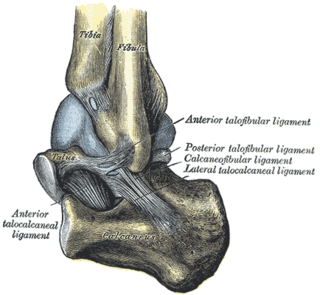Related Research Articles
The Nomina Anatomica Veterinaria is an standardized nomenclature. It is made by World Association of Veterinary Anatomists (WAVA). It is used as the standard reference for anatomical (zootomical) terminology in the field of veterinary science regarding domestic mammals. It is based on cats, dogs, pigs, cows, sheep, goats, rabbits and horses—horses being their main subjects.

The raphe nuclei are a moderate-size cluster of nuclei found in the brain stem. They have 5-HT1 receptors which are coupled with Gi/Go-protein-inhibiting adenyl cyclase. They function as autoreceptors in the brain and decrease the release of serotonin. The anxiolytic drug Buspirone acts as partial agonist against these receptors. Selective serotonin reuptake inhibitor (SSRI) antidepressants are believed to act in these nuclei, as well as at their targets.

A fascia is a generic term for macroscopic membranous bodily structures. Fasciae are classified as superficial, visceral or deep, and further designated according to their anatomical location.

The buccinator is a thin quadrilateral muscle occupying the interval between the maxilla and the mandible at the side of the face. It forms the anterior part of the cheek or the lateral wall of the oral cavity.

The thyroid cartilage is the largest of the nine cartilages that make up the laryngeal skeleton, the cartilage structure in and around the trachea that contains the larynx. It does not completely encircle the larynx.

The iris dilator muscle, is a smooth muscle of the eye, running radially in the iris and therefore fit as a dilator. The pupillary dilator consists of a spokelike arrangement of modified contractile cells called myoepithelial cells. These cells are stimulated by the sympathetic nervous system. When stimulated, the cells contract, widening the pupil and allowing more light to enter the eye.

The anconeus muscle is a small muscle on the posterior aspect of the elbow joint.

The ilium is the uppermost and largest region of the coxal bone, and appears in most vertebrates including mammals and birds, but not bony fish. All reptiles have an ilium except snakes, although some snake species have a tiny bone which is considered to be an ilium.
Nomina Anatomica (NA) was the international standard on human anatomic terminology from 1895 until it was replaced by Terminologia Anatomica in 1998.
Terminologia Anatomica is the international standard for human anatomical terminology. It is developed by the Federative International Programme on Anatomical Terminology, a program of the International Federation of Associations of Anatomists (IFAA).

The ligamentum venosum, also known as Arantius' ligament, is the fibrous remnant of the ductus venosus of the fetal circulation. Usually, it is attached to the left branch of the portal vein within the porta hepatis. It may be continuous with the round ligament of liver.
The International Federation of Associations of Anatomists (IFAA) is an umbrella scientific organization of national and multinational Anatomy Associations, dedicated to anatomy and biomorphological sciences.

The annular ligament is a strong band of fibers that encircles the head of the radius, and retains it in contact with the radial notch of the ulna.

The inferior tibiofibular joint, also known as the distal tibiofibular joint, is formed by the rough, convex surface of the medial side of the distal end of the fibula, and a rough concave surface on the lateral side of the tibia.

The accessory meningeal artery is a branch of the maxillary artery that ascends through the foramen ovale to enter the cranial cavity and supply the dura mater of the floor of the middle cranial fossa and of the trigeminal cave, and to the trigeminal ganglion.

The fibularis muscles are a group of muscles in the lower leg.
The Terminologia Histologica (TH) is the controlled vocabulary for use in cytology and histology. In April 2011, Terminologia Histologica was published online by the Federative International Programme on Anatomical Terminologies (FIPAT), the successor of FCAT.
The Federative International Programme for Anatomical Terminology (FIPAT) is a group of experts who review, analyze, and discuss the terms of the morphological structures of the human body. It was created by the International Federation of Associations of Anatomists (IFAA) and was previously known as the Federative Committee on Anatomical Terminology (FCAT) and the Federative International Committee on Anatomical Terminology (FICAT).

Anatomical terminology is a form of scientific terminology used by anatomists, zoologists, and health professionals such as doctors, physicians, and pharmacists.
The venous plexus of hypoglossal canal is a small venous plexus surrounding the hypoglossal nerve as it passes through the hypoglossal canal. The plexus connects with the occipital sinus (intercranially), inferior petrosal sinus (intercranially), internal jugular vein (extracranially), condylar vein, and paravertebral venous plexus.
References
- ↑ "IFAA". Archived from the original on 2022-01-18. Retrieved 2011-05-02.
- ↑ "IFAA History". Archived from the original on 2007-09-29. Retrieved 2007-12-06.
- ↑ prepared by subcommittees of the International Anatomical Nomenclature Committee appointed at the seventh International Congress of Anatomists in New York, 1960, based upon provisional versions approved by the ninth international congress in Leningrad, 1970. (1977). Nomina anatomica: approved by the Tenth International Congress of Anatomists at Tokyo, August 1975, together with Nomina histologica and Nomina embryologica. Amsterdam: Excerpta Medica. ISBN 0-444-15259-8.
{{cite book}}: CS1 maint: multiple names: authors list (link) CS1 maint: numeric names: authors list (link) - ↑ Arráez-aybar; González-Lorrio, F.; Marantos-Gamarra, D. G.; Jiménez-Collado, J. (2003). "Cardiac developmental onomatology: the real heart of the matter". Annals of Anatomy - Anatomischer Anzeiger. 185 (6): 525–533. doi:10.1016/S0940-9602(03)80119-X. PMID 14703997.